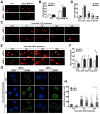The replicative senescent mesenchymal stem / stromal cells defect in DNA damage response and anti-oxidative capacity
- PMID: 30008586
- PMCID: PMC6036081
- DOI: 10.7150/ijms.24635
The replicative senescent mesenchymal stem / stromal cells defect in DNA damage response and anti-oxidative capacity
Abstract
Replicative senescence and potential malignant transformation are great limitations in the clinical application of bone marrow-derived mesenchymal stem / stromal cells (MSCs). An abnormal DNA damage response may result in genomic instability, which is an integral component of aging and tumorigenesis. However, the effect of aging on the DNA damage response in MSCs is currently unknown. In the present study, we evaluated the DNA damage response induced by oxidative stress and DNA double-strand breaks in human bone marrow-derived MSCs. After long-term cell culture, replicative senescent MSCs (sMSCs) were characterized by a poor proliferation rate, high senescence-associated β-galactosidase activity, and enhanced expression of P53 and P16. Features of the DNA damage response in these sMSCs were then compared with those from early-passage MSCs. The sMSCs were more sensitive to hydrogen peroxide and bleomycin treatment with respect to cell viability and apoptosis induction. Combined with the comet assay, γH2AX foci characterization and reactive oxygen species detection were used to demonstrate that the antioxidant and DNA repair ability of sMSCs are attenuated. This result could be explained, at least in part, by the downregulation of anti-oxidation and DNA repair genes, including Cu/Zn-SOD, GPX, CAT, OGG1, XRCC1, Ku70, BRCA2 and XRCC4. In conclusion, MSCs aging is associated with a reduction in the DNA repair and anti-oxidative capacity.
Keywords: DNA damage response; DNA double-strand breaks; Replicative senescence; mesenchymal stem cells; oxidative stress.
Conflict of interest statement
Competing Interests: The authors have declared that no competing interest exists.
Figures





Similar articles
-
Accumulation of apoptosis-insensitive human bone marrow-mesenchymal stromal cells after long-term expansion.Cell Biochem Funct. 2016 Jul;34(5):310-6. doi: 10.1002/cbf.3191. Epub 2016 May 22. Cell Biochem Funct. 2016. PMID: 27212655
-
Quantifying Senescence-Associated Phenotypes in Primary Multipotent Mesenchymal Stromal Cell Cultures.Methods Mol Biol. 2019;2045:93-105. doi: 10.1007/7651_2019_217. Methods Mol Biol. 2019. PMID: 31020633
-
Senescence of bone marrow-derived mesenchymal stem cells from patients with idiopathic pulmonary fibrosis.Stem Cell Res Ther. 2018 Sep 26;9(1):257. doi: 10.1186/s13287-018-0970-6. Stem Cell Res Ther. 2018. PMID: 30257725 Free PMC article.
-
DNA damage repair response in mesenchymal stromal cells: From cellular senescence and aging to apoptosis and differentiation ability.Ageing Res Rev. 2020 Sep;62:101125. doi: 10.1016/j.arr.2020.101125. Epub 2020 Jul 16. Ageing Res Rev. 2020. PMID: 32683038 Review.
-
Exploring Microenvironment Strategies to Delay Mesenchymal Stem Cell Senescence.Stem Cells Dev. 2022 Feb;31(3-4):38-52. doi: 10.1089/scd.2021.0254. Epub 2022 Jan 21. Stem Cells Dev. 2022. PMID: 34913751 Review.
Cited by
-
DNA damage response manages cell cycle restriction of senile multipotent mesenchymal stromal cells.Mol Biol Rep. 2020 Jan;47(1):809-818. doi: 10.1007/s11033-019-05150-6. Epub 2019 Oct 29. Mol Biol Rep. 2020. PMID: 31664596 Review.
-
Immunomodulating Profile of Dental Mesenchymal Stromal Cells: A Comprehensive Overview.Front Oral Health. 2021 Mar 31;2:635055. doi: 10.3389/froh.2021.635055. eCollection 2021. Front Oral Health. 2021. PMID: 35047993 Free PMC article.
-
Differential SOD2 and GSTZ1 profiles contribute to contrasting dental pulp stem cell susceptibilities to oxidative damage and premature senescence.Stem Cell Res Ther. 2021 Feb 17;12(1):142. doi: 10.1186/s13287-021-02209-9. Stem Cell Res Ther. 2021. PMID: 33596998 Free PMC article.
-
Rejuvenation of Senescent Mesenchymal Stem Cells to Prevent Age-Related Changes in Synovial Joints.Cell Transplant. 2023 Jan-Dec;32:9636897231200065. doi: 10.1177/09636897231200065. Cell Transplant. 2023. PMID: 37766590 Free PMC article. Review.
-
The RXFP3 receptor is functionally associated with cellular responses to oxidative stress and DNA damage.Aging (Albany NY). 2019 Dec 3;11(23):11268-11313. doi: 10.18632/aging.102528. Epub 2019 Dec 3. Aging (Albany NY). 2019. PMID: 31794429 Free PMC article.
References
-
- Pittenger MF, Mackay AM, Beck SC, Jaiswal RK, Douglas R, Mosca JD. et al. Multilineage potential of adult human mesenchymal stem cells. Science. 1999;284:143–7. - PubMed
-
- Prockop DJ. Marrow stromal cells as stem cells for nonhematopoietic tissues. Science. 1997;276:71–4. - PubMed
-
- Squillaro T, Peluso G, Galderisi U. Clinical Trials With Mesenchymal Stem Cells: An Update. Cell transplantation. 2016;25:829–48. - PubMed
-
- Chen Y, Shao JZ, Xiang LX, Dong XJ, Zhang GR. Mesenchymal stem cells: a promising candidate in regenerative medicine. International Journal of Biochemistry & Cell Biology. 2008;40:815–20. - PubMed
-
- Ksiazek K. A comprehensive review on mesenchymal stem cell growth and senescence. Rejuvenation research. 2009;12:105–16. - PubMed
MeSH terms
Substances
LinkOut - more resources
Full Text Sources
Other Literature Sources
Research Materials
Miscellaneous

